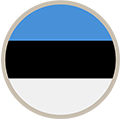
| Indirect tax snapshot | |
|---|---|
|
What are the current rate(s) of VAT? |
|
|
Are there any confirmed or anticipated changes to these rates? |
From 1 July 2025 until 31 December 2028 standard rate will be increased to 24%. |
|
What is the principal indirect tax? |
Value Added Tax (VAT) is the principal indirect tax in Estonia. It is a tax on consumer expenditure and is collected on business transactions and imports. |
|
Is there a registration limit for the tax? |
Yes. If the taxable supply of the transactions, including 0% taxable supply and supply of real estate transactions and insurance and financial services, except occasional services, and excluding transfer of fixed assets, carried out by a person exceeds €40,000 as calculated from the beginning of a calendar year, an obligation to register as a taxable person arises.
|
|
Does the same registration limit apply to non-established businesses? |
Yes, the same registration limit applies to non-established businesses operating based on a small enterprise special scheme in the Community and registration liability will arise if taxable supply in Estonia exceeds €40,000.
For non-established businesses with no permanent establishment in Estonia, registration liability arises from first taxable supply for which place of supply is Estonia, unless such supply is taxed in Estonia upon acquisition by the recipient of the supply. However, registration is not required if all sales are taxed at a 0% VAT rate, except for intra-Community supply of goods or sales made through an online marketplace where the marketplace is considered to be the acquirer. . Businesses from other EU countries or third countries providing services, intra-Community distance sales, or selling through an online marketplace do not need to register in Estonia if they are already registered for a special VAT scheme in another EU country.
|
|
Does a non-established person need to appoint a fiscal representative in order to register?
|
A person of a third country engaged in business with no permanent business establishment in Estonia with whose country of residence the Union has not concluded a mutual assistance contract concerning administrative cooperation, the fight against fraud and the recovery of claims relating to the value added tax, is required to, upon registration as a taxable person, appoint a tax representative specified in the Taxation Act, who has been approved by the tax authority. Currently EU has such agreements with Norway and UK, and for all other third countries appointing a licensed tax representative is mandatory.
|
|
How often do returns have to be submitted? |
The taxable period is one calendar month. The VAT return must be submitted to the tax authority by the 20th day of the month following the taxable period.
|
|
Are penalties imposed for the late submission of returns/payment of tax? |
Yes. If a VAT return, or the corresponding payment, is submitted late a penalty can be imposed. If the VAT payment is late an interest of a 0.06% per day is calculated based on the payable amount (i.e., 21,9% per year).
|
|
Are any other declarations required? |
Yes. EC Sales list has to be submitted in respect of certain supplies made to customers who are registered for VAT elsewhere in the EU. Intrastat declaration for dispatches also have to be submitted in certain circumstances .
|
|
Are penalties imposed in other circumstances? |
Yes. Penalties can be imposed for a range of errors or omissions.
|
|
Can the tax incurred by overseas businesses be claimed if they are not registered in your country? |
Yes, in certain circumstances and subject to certain conditions.
|
|
Deduction of VAT |
The VAT of goods or services relating to the reception of guests or the provision of meals or accommodation for employees is not deductible. In certain circumstances, when acquiring an automobile and purchasing of goods and receiving of services for such an automobile then 50% of the input VAT is deductible when the automobile is being used also for private purposes. |
Please click on each section to expand further:
Contact us
For further information on indirect tax in Estonia please contact:

Kristjan Järve
T: +372 626 4500
E: kristjan.jarve@ee.gt.com

Nadežda Mihhailitšenko
T: +372 626 0500
E: nadezda.mihhailitsenko@ee.gt.com

Jaana Sild
T: +372 626 4500
E: jaana.sild@ee.gt.com
